Chairman of the Joint Chiefs (Philippines)
The Chairman of the Joint Chiefs is the highest-ranking military officer (except for the President of the Philippines who holds the position of Commander-in-Chief equivalent to a 5-star general) and the head of the Armed Forces of the Philippines (AFP) including all service branches (Army, Air Force, Navy–Marine Corps, Coast Guard—in Wartime Attached Service) under its command. The position is usually held by a four-star rank of General/Admiral and was formerly known as the "Chief of Staff of the Armed Forces of the Philippines" until June 2020. Its direct equivalent in the US Armed Forces is the Chairman of the Joint Chiefs of Staff. Unlike his US counterpart which is merely supervisory, the Chairman has complete operational control and is responsible for overall operations of the AFP.[4]
| Chairman of the Joint Chiefs | |
|---|---|
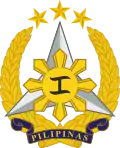 Emblem of the Armed Forces of the Philippines | |
.svg.png.webp) Flag of the Chairman of the Joint Chiefs | |
| Reports to | Secretary of National Defense President of the Philippines |
| Seat | Camp Aguinaldo, Quezon City |
| Appointer | The President with the consent of the Commission on Appointments |
| Term length | Mandatory retirement at age 56.[1] Can be extended until 3 years |
| Constituting instrument | Republic Act No. 8186[2][3] |
| Formation | March 22, 1897 (Revolutionary) December 21, 1935 (Official) |
| First holder | Artemio Ricarte (Revolutionary) Jose Delos Reyes (AFP) |
| Deputy | Vice-Chairman of the Joint Chiefs (Assistant) Chief of the Joint Staff (Administrative and Organizational Duties) |
| Website | Philippine Armed Forces |
The holder of this position is appointed by, as well as directly reports to the President of the Philippines under the Article VII, Section 18 of the 1987 Constitution.[5] He executes the President's commands, tactics, operations, plannings, and strategies, as well as serves as the Immediate Adviser to the Secretary of National Defense. He also prescribes directions to all commands (including the Chief of the Army, the Chief of the Air Force, the Chief of the Navy, the Joint Forces Commanders of Unified Commands, and the AFP Board of Generals).
The Armed Forces of the Philippines were created as a result of the National Defense Act of 1935 (Commonwealth Act No. 1). However, the origin of the organization can be traced back to the establishment of the Philippine Constabulary, armed Filipino forces organized in 1901 by the United States to combat the Philippine Revolutionary Army then led by General Emilio Aguinaldo.
History
The position of the Chief of Staff has been traced from the Commanding General of the Philippine Army, when the Philippine Commonwealth Army (now the Philippine Army) was established as the main army of the Commonwealth of the Philippines. After the defeat of the First Philippine Republic during the Philippine–American War, the United States dissolved the army and relied on its armed forces together with some Filipino troops under the Philippine Constabulary. However, the National Defense Act of 1935 led to take on responsibilities on national defense and pave way for the creation of three major commands (Army, Air Force, Navy). Since the 1960s, the rosters of the Chiefs of Staff is arranged accordingly.[6]
The AFP Chief was assisted by the Vice Chief of Staff of the AFP and The Deputy Chief of Staff of the AFP, both holders of the rank of Lieutenant General/Vice Admiral. The Vice Chief of Staff serves as the assistant of the AFP Chief in their operational duties, they also assists the AFP Chief in their absence, while The Deputy Chief of Staff supervises the organizational staff, overall policy and strategy, and perform other duties assigned by the AFP Chief.
On June 19, 2020, under the DND Order no. 174, the title of Chief of Staff was renamed as the Chairman of the Joint Chiefs, while the Vice Chief of Staff as Vice Chairman of the Joint Chiefs, and the Deputy Chief of Staff as Chief of the Joint Staff.[7]
Officeholders
Commanding Generals of the Philippine Revolutionary Army
| No. | Portrait | Chief of Staff | Took office | Left office | Time in office | Service branch |
|---|---|---|---|---|---|---|
| – | Captain General Artemio Ricarte (1866–1945) [lower-alpha 1] | March 22, 1897 | January 22, 1899 | 1 year, 306 days | .svg.png.webp) Revolutionary Army | |
| – | General Antonio Luna (1866–1899) [lower-alpha 2] | January 22, 1899 | June 5, 1899 † | 134 days | .svg.png.webp) Revolutionary Army | |
| – | General Emilio Aguinaldo (1869–1964) [lower-alpha 3] | June 5, 1899 | March 23, 1901 | 1 year, 291 days | .svg.png.webp) Revolutionary Army |
- Ricarte was elected Captain-General by the Tejeros Convention.
- Luna was assassinated by General Aguinaldo's men
- Aguinaldo personally took charge after General Antonio Luna's assassination.
Chiefs of Staff of the AFP
| No. | Portrait | Chief of Staff | Took office | Left office | Time in office | Service branch |
|---|---|---|---|---|---|---|
| 1 | Major General Jose de los Reyes | December 21, 1935 | May 6, 1936 | 137 days | 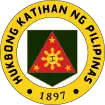 Philippine Army | |
| 2 | Major General Paulino Santos (1890–1945) | May 6, 1936 | December 31, 1938 | 2 years, 239 days |  Philippine Army | |
| 3 | Major General Basilio Valdes (1892–1970) | January 1, 1939 | November 7, 1945 | 6 years, 310 days |  Philippine Constabulary | |
| 4 | Major General Rafael Jalandoni | December 21, 1945 | December 20, 1948 | 2 years, 365 days |  Philippine Constabulary | |
| 5 | Major General Mariano Castañeda (1892–1970) | December 21, 1948 | May 28, 1951 | 2 years, 158 days |  Philippine Constabulary | |
| 6 | Major General Calixto Duque | June 2, 1951 | December 30, 1953 | 2 years, 211 days |  Philippine Army | |
| 7 | Lieutenant General Jesus Vargas | December 30, 1953 | December 29, 1956 | 2 years, 365 days |  Philippine Army | |
| 8 | Lieutenant General Alfonso Arellano | December 29, 1956 | December 31, 1958 | 2 years, 2 days |  Philippine Army | |
| 9 | Lieutenant General Manuel Cabal | January 1, 1959 | December 30, 1961 | 2 years, 363 days |  Philippine Constabulary | |
| 10 | Lieutenant General Pelagio Cruz (1912–1986) | December 30, 1961 | August 31, 1962 | 244 days | 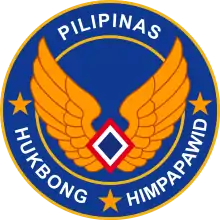 Philippine Air Force | |
| 11 | General Alfredo Santos (1905–1990) | September 1, 1962 | July 12, 1965 | 2 years, 314 days |  Philippine Army | |
| 12 | General Rigoberto Atienza | July 13, 1965 | January 22, 1966 | 193 days |  Philippine Army | |
| 13 | General Ernesto Mata (1915–2012) | January 22, 1966 | January 21, 1967 | 364 days |  Philippine Army | |
| 14 | General Victor Osias | January 21, 1967 | August 15, 1967 | 206 days |  Philippine Air Force | |
| 15 | General Segundo Velasco | August 15, 1967 | May 27, 1968 | 286 days |  Philippine Army | |
| 16 | General Manuel Yan (1920–2008) [lower-alpha 1] | May 28, 1968 | January 15, 1972 | 3 years, 232 days |  Philippine Constabulary | |
| 17 | General Romeo Espino [lower-alpha 2] | January 15, 1972 | August 15, 1981 | 9 years, 212 days |  Philippine Army | |
| 18 | General Fabian Ver (1920–1998) [lower-alpha 3] | August 15, 1981 | October 24, 1984 | 3 years, 70 days | .svg.png.webp) Philippine Constabulary | |
| 19 | General Fidel Ramos (born 1928) | October 24, 1984 | December 2, 1985 | 1 year, 39 days | .svg.png.webp) Philippine Constabulary | |
| (18) | General Fabian Ver (1920–1998) | December 2, 1985 | February 25, 1986 | 85 days | .svg.png.webp) Philippine Constabulary | |
| (19) | General Fidel Ramos (born 1928) [lower-alpha 4] | February 25, 1986 | January 23, 1988 | 1 year, 332 days | .svg.png.webp) Philippine Constabulary | |
| 20 | General Renato de Villa (born 1935) [lower-alpha 5] | January 25, 1988 | January 23, 1991 | 2 years, 363 days | .svg.png.webp) Philippine Constabulary | |
| 21 | General Rodolfo Biazon (born 1935) [lower-alpha 6] | January 24, 1991 | April 12, 1991 | 78 days | 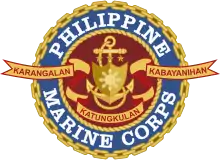 Philippine Marine Corps | |
| 22 | General Lisandro Abadia | April 12, 1991 | April 12, 1994 | 3 years, 0 days |  Philippine Army | |
| 23 | General Arturo Enrile (1940–1998) [lower-alpha 7] | April 15, 1994 | November 28, 1996 | 227 days |  Philippine Army | |
| 24 | General Arnulfo Acedera Jr. (1941–2020) | November 28, 1996 | December 18, 1997 | 1 year, 20 days |  Philippine Air Force | |
| 26 | General Clemente Mariano | December 18, 1997 | June 30, 1998 | 194 days |  Philippine Army | |
| 27 | General Joselino Nazareno [lower-alpha 8] | July 1, 1998 | July 8, 1999 | 1 year, 7 days |  Philippine Army | |
| 28 | General Angelo Reyes (1945–2011) [lower-alpha 9] | July 8, 1999 | March 17, 2001 | 1 year, 252 days |  Philippine Army | |
| 29 | General Diomedio Villanueva | March 17, 2001 | May 18, 2002 | 1 year, 62 days |  Philippine Army | |
| 30 | General Roy Cimatu (born 1946) [lower-alpha 10] | May 18, 2002 | September 10, 2002 | 115 days |  Philippine Army | |
| 31 | General Benjamin Defensor Jr. | September 10, 2002 | November 28, 2002 | 79 days |  Philippine Air Force | |
| 32 | General Dionisio Santiago [lower-alpha 11] | November 28, 2002 | April 8, 2003 | 131 days |  Philippine Army | |
| 34 | General Narciso Abaya | April 8, 2003 | October 29, 2004 | 1 year, 204 days |  Philippine Army | |
| 35 | General Efren Abu | October 29, 2004 | August 15, 2005 | 290 days |  Philippine Army | |
| 36 | General Generoso Senga | August 15, 2005 | July 22, 2006 | 341 days |  Philippine Army | |
| 37 | General Hermogenes Esperon Jr. (born 1952) [lower-alpha 12] | July 22, 2006 | May 12, 2008 | 1 year, 295 days |  Philippine Army | |
| 38 | General Alexander Yano [lower-alpha 13] | May 12, 2008 | May 1, 2009 | 354 days |  Philippine Army | |
| 39 | General Victor Ibrado | May 1, 2009 | March 10, 2010 | 313 days |  Philippine Army | |
| 40 | General Delfin Bangit (1955–2013) | March 10, 2010 | June 22, 2010 | 104 days |  Philippine Army | |
| – | Lieutenant General Nestor Ochoa Acting | June 22, 2010 | June 30, 2010 | 8 days |  Philippine Army | |
| 41 | General Ricardo David (born 1955) [lower-alpha 14] | July 2, 2010 | March 7, 2011 | 248 days |  Philippine Army | |
| 42 | General Eduardo Oban Jr. (born 1955) | March 7, 2011 | December 12, 2011 | 280 days |  Philippine Air Force | |
| 43 | General Jessie Dellosa (born 1957) | December 12, 2011 | January 20, 2013 | 1 year, 39 days |  Philippine Army | |
| 44 | General Emmanuel Bautista (born 1958) | January 20, 2013 | July 18, 2014 | 1 year, 179 days |  Philippine Army | |
| 45 | General Gregorio Pio Catapang (born 1959) [lower-alpha 15] | July 18, 2014 | July 10, 2015 | 357 days |  Philippine Army | |
| 46 | General Hernando Delfin Carmelo A. Iriberri (born 1960) [8] | July 10, 2015 | April 22, 2016 | 287 days |  Philippine Army | |
| – | Lieutenant General Glorioso Miranda (born 1961) Acting | April 22, 2016 | June 30, 2016 | 69 days |  Philippine Army | |
| 47 | General Ricardo Visaya (born 1960) [lower-alpha 16] | July 1, 2016 | December 7, 2016 | 159 days |  Philippine Army | |
| 48 | General Eduardo Año (born 1961) [lower-alpha 17] | December 7, 2016 | October 26, 2017 | 323 days |  Philippine Army | |
| 49 | General Rey Leonardo Guerrero (born 1961) [lower-alpha 18] | October 26, 2017 | April 18, 2018[10] | 174 days |  Philippine Army | |
| 50 | General Carlito Galvez Jr. (born 1962) [lower-alpha 19] | April 18, 2018 | December 11, 2018 | 237 days |  Philippine Army | |
| 51 | General Benjamin Madrigal Jr. (born 1963) [lower-alpha 20] | December 11, 2018 | September 24, 2019 | 287 days |  Philippine Army | |
| 52 | General Noel Clement (born 1964) | September 24, 2019 | January 4, 2020 | 102 days |  Philippine Army |
Chairmen of the Joint Chiefs of the AFP
| No. | Portrait | Chief of Staff | Took office | Left office | Time in office | Service branch |
|---|---|---|---|---|---|---|
| 53 | General Felimon Santos Jr. (born 1964) | January 4, 2020 | August 3, 2020 | 212 days |  Philippine Army | |
| 54 | General Gilbert Gapay (born 1965) | August 3, 2020 | February 4, 2021 | 185 days |  Philippine Army | |
| 55 | Lieutenant General Cirilito Sobejana (born 1965) | February 4, 2021 | Incumbent | 0 days |  Philippine Army |
See also
Notes
- Yan served as the youngest chief of Staff of the Armed Forces of the Philippines at the age of 48. Prior to that, he was the chief of the Philippine Constabulary. He currently holds the record for longest continuous government service from 1937– 2001 or 64 years of service.
- Espino served as the Commanding General of the Philippine Army before appointed to become the top military man. Espino is the longest-serving Chief of Staff of the Armed Forces of the Philippines for nine years, especially during the martial law regime. A second product of the ROTC. During his term, he was fair in administering the military, unlike his successor, General Fabian Ver.
- Ver was considered a loyalist and the second most powerful man in the country next to President Ferdinand Marcos in the later years of his authoritarian regime, replacing then Defense Minister Juan Ponce Enrile, who held the status since 1972 when Marcos named him as martial law administrator upon the imposition of martial law. Ver, in fact, was the most powerful military officer at that time for, aside from being the top military man, he was also the commander of the Presidential Security Command and the director-general of NISA, the Marcos regime's secret police. The third military officer appointed as chief of staff that came from ROTC. During his term, he was known for his favoritism especially in the promotion of officers.
- Ramos then, before becoming the chief of the now defunct Philippine Constabulary in 1972, he was the commander of Philippine Army's 3rd Division in Cebu. On the 1980s he was promoted into vice-chief of staff with the rank of lieutenant general but remained as PC chief. After the EDSA revolt that ousted Marcos his cousin from power, he became the AFP chief. Later after retiring as AFP chief of staff during the term of President Corazon C. Aquino served as Secretary of National Defense and was elected the 12th President of the Republic of the Philippines in 1992 and served until 1998. He is the 2nd Army General who became the President of the Republic after Gen. Aguinaldo.
- Prior to becoming chief of staff, in 1986, de Villa was named to be the chief of the Philippine Constabulary (now defunct), then an AFP major service acting as the country's police force while he was also named to be AFP vice-chief of staff with the rank of three-star general. Upon retirement, de Villa served as Secretary of National Defense when he retired in 1991 and ran for president but lost to Joseph Estrada and Executive Secretary under President Gloria Macapagal-Arroyo.
- Biazon served in the Philippine Senate and the House of Representatives after his retirement as AFP chief of staff in 1991. He is the first and only Chief of Staff from the PMC. Prior to that, he served as the commander of the AFP NCR Defense Command in 1988 and Commandant of the Philippine Marine Corps in 1987. He had also served as the superintendent of the Philippine Military Academy in 1986.
- Enrile later served as Secretary of the DOTC under President Fidel Ramos.
- Later served as Ambassador to Pakistan.
- Reyes later served as Secretary of National Defense, Secretary of DILG, Secretary of DENR, and Secretary of DOE under President Gloria Macapagal-Arroyo.
- Cimatu later served as Special Envoy to the Middle East. Cimatu served as the Secretary of the DENR under President Rodrigo Roa Duterte.
- Later served as the director-general of the Philippine Drug Enforcement Agency.
- Esperon later served as Presidential Adviser on Peace Process under President Gloria Macapagal-Arroyo. Esperon served as National Security Adviser under President Rodrigo Roa Duterte.
- Yano later served as our country's Ambassador to Brunei.
- David later served as Bureau of Immigration Commissioner under President Benigno Aquino III.
- Later served as Bases Conversion Development Agency Board Member.
- Later served as the Administrator of the National Irrigation Administration (NIA) under President Rodrigo Roa Duterte.[9]
- Later served as the Secretary of the Department of the Interior and Local Government (DILG) under President Rodrigo Roa Duterte[8]
- Later served as the Administrator of the Maritime Industry Authority (MARINA) and later as Commissioner of the Bureau of Customs under President Rodrigo Roa Duterte
- Later served as the Presidential Adviser on the Peace Process
- Madrigal later served as a member of the governing board of the Philippine Coconut Authority.
References
- "Gen. Glorioso Miranda named as acting AFP chief". CNN Philippines. April 22, 2016. Retrieved July 1, 2016.
- Macas, Trisha (December 7, 2017). "Duterte extends AFP chief Guerrero's term". GMA News Online. Retrieved November 26, 2018.
- "REPUBLIC ACT NO. 8186". Chan Robles. Retrieved November 26, 2018.
- "MaxDefense received confirmation that AFP has deferred the use of the new designation names, President has not yet approved the use of these". July 26, 2020.
- "CONSTITUTION OF THE REPUBLIC OF THE PHILIPPINES – ARTICLE VII".
- "Chief of Staff of the Armed Forces of the Philippines". Official Gazette.
- Mangosing, Frances (July 13, 2020). "PH military adopting new titles: Chief of staff now Joint Chiefs Chair". Philippine Daily Inquirer. Retrieved July 13, 2020.
- "Rebel hunter Año is new AFP chief". Rappler. December 7, 2016. Retrieved December 7, 2016.
- "Duterte leads AFP change of command rites". Sun.Star Manila. July 1, 2016. Retrieved July 1, 2016.
- "Hello, goodbye, General Guerrero". Philippine Daily Inquirer. December 7, 2017. Retrieved December 7, 2017.

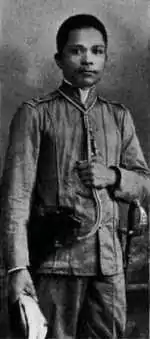

.jpg.webp)

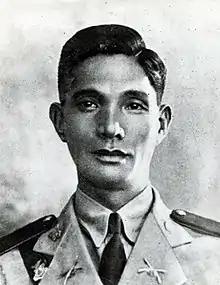
.jpg.webp)
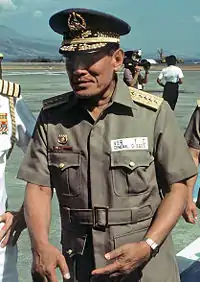
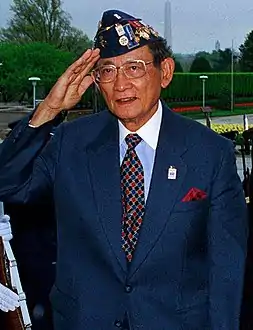
.jpg.webp)


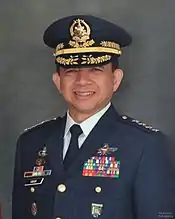



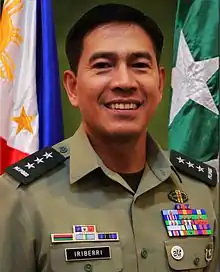
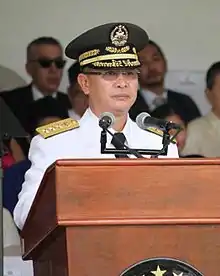
.jpg.webp)
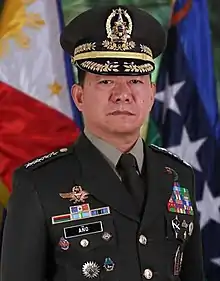
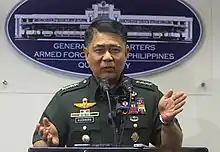
.jpg.webp)
.jpg.webp)


